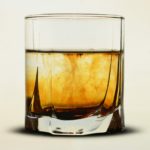When you hear the term “proof” regarding liquor, it’s referring to the amount of alcohol in the bottle. The proof of a bottle will typically be double the alcohol by volume, or ABV, of the liquor inside.
The term comes from the 16th century when sailors would test to see if their alcoholic spirits were strong enough by burning them with gunpowder. If the spirit burned, there was enough alcohol in the blend—and that was their proof.
If liquor is bottled at 80 proof, that means it has an ABV of 40%. If liquor is bottled at 120 proof, that means it has an ABV of 60%.
If you’ve spent even a little bit of time browsing the shelves of your local liquor store, you will notice that most of the liquors are bottled at 80 proof. For years, this standard of proofing has served as the most popular alcohol level on the market.
But why? Well, technically, it’s the law. For most spirits like whiskey, bourbon, vodka, gin, and tequila,
80 proof is the legal minimum alcohol level required.
The proof can go higher than 80, but usually, most brands choose to stick to the classic 40% ABV. 80 proof liquor can already be very intoxicating, so most consumers stick by this 40% level.
To continue learning about 80 proof liquor and why this bottling style is so popular, keep reading.
Why 80 proof is the magic number
Alcohol is a major factor in the makeup of spirits. The alcohol gives the drink structure and texture and also helps potentiate its flavor. The secret to crafting an immaculate spirit is to find the perfect balance between alcohol content and flavor profile.
More than often, this balance is found at around the 40% level of alcohol content. This recipe is so time-tested that spirits like vodka, tequila, and white rum are almost exclusively bottled at 80 proof.
Some spirits, though, like whiskey, can be bottled at 120 proof and above. However, these liquors are not meant to be drunk straight. They’re usually used as ingredients for cocktails.
Another reason that producers bottle spirits at the minimum amount of alcohol required is to save money. The higher the proof of a bottle is, the higher it will be taxed.
Though some specialty spirit brands will toy with liquors that cross this threshold of 40%, for mass-producing, conglomerate companies, it simply isn’t worth it. There isn’t enough demand, and it isn’t worth paying additional taxes for.
Have you ever tasted a spirit that lacked acidity? Or a cocktail that didn’t have enough punch to it? The alcohol content does more than just get you buzzed; it shapes the entire drink.
The history of 80 proof
The tradition of bottling spirits at 80 proof has years of lineage behind it. Even the number, which would otherwise seem arbitrary, holds some historical significance.
The two ways of measuring the strength of spirits are to measure the alcohol by volume in a bottle or alcohol by weight. In the past, the English used alcohol by weight to measure their liquor. The lowest amount of alcohol they would accept was around 30 degrees under proof by weight, which equates to 39.9% ABV.
In 1936, American legislators passed the Federal Alcohol Administration Act, which set the standard of producing spirits to a rounded-up 40% ABV. This remains the standard to this day.
The process of bottling 80 proof
So how is the proofing process completed? Well, producers reach their desired level of alcohol by adding water to their mixture.
Most spirits are made by compounding raw materials like grapes, grains, or agave, fermenting them, distilling them, then aging them. When these spirits come out of their cask after they matured, they typically contain an obscenely high amount of alcohol.
The only way to lower the alcohol content is by adding water. This process is known as proofing down.
Sometimes, producers will use slow reduction to gradually add water day by day to a blend, rather than all at once. This technique preserves the flavors and aromas in the spirit and prevents it from becoming too watered down.
You can even proof down your own spirits at home if you feel that a bottle is too strong for you. Just add a teaspoon of water at a time to the bottle until you’ve reached your desired taste.
Some spirit enthusiasts advocate for the quality of cask strength spirits, which are not proofed at all. These spirits are considered to contain the fullest amount of flavor possible from their barrel.
Be wary, though; just because a spirit is cask strength doesn’t mean it’s high quality. If not distilled properly, the spirit can still turn out to be low in alcohol content even when bottled straight from the cask.
Consumer demand for 80 proof
Nowadays, it’s common to find spirits bottled at 80 proof. The practice has been legal since the 1930s. But it wasn’t until the 1950s when producers began releasing bottles under 100 proof.
The trend was influenced by consumer demand, which was leaning toward lighter-profile liquors. During Prohibition, Americans really gained a taste for lighter spirits when 80 proof Canadian whiskeys and lower-proof blends of Scotch began to be smuggled into the country.
U.S. distillers saw this shift in preference and took full advantage. At first, producers started diluting their spirits to 86 proof. Then, in the 1980s, the 80 proof bottle took over. The style of bottling has seen a steady rise in popularity since.
Back then, people were mainly enjoying high-proof spirits like whiskey with soft drinks. But as the alcohol content of spirits began to decrease, these drinks began to be enjoyed straight more often.
80 proof cocktails
Of course, 80 proof spirits are great to drink straight. But they’re also wonderful ingredients in cocktails. With how much of a kick they provide, it’s a no-brainer to throw in an 80 proof spirit into your next mixed drink.
If you’re a fan of bourbon or whiskey, there’s no better cocktail to try than the Old Fashioned. This classic mixed drink has over 200 years of history behind it and is one of the most popular cocktails of all time. All you need is bitters, sugar cubes, and garnish to make a great Old Fashioned.
Another delicious and simple cocktail to make is the Vodka Soda. It’s exactly what it sounds like. Just choose your favorite style of vodka and get to mixing. Add a squeeze of lemon for some extra flavor.
The next cocktail on our list is the classic Gin and Juice. In addition to being referenced by the rap artist and hip hop mogul Snoop Dogg, a Gin and Juice provides a great balance of flavors and textures. You can use orange juice, apple juice, grape juice, or all of the above.
The dryness of the gin blended with the juiciness of the fruit is a match made in heaven. Add some simple syrup for an added touch of sweetness.
80 proof brands to try
With so many spirits on the market today, it can be pretty overwhelming when you go out to shop for liquor. To help you out, we’ve put together a shortlist of some of our favorites.
The Johnny Drum Green Label 80 Blended Bourbon is one of the finest expressions of blended bourbon. Johnny Drum is produced in limited quantities due its tedious production process, which follows an old family recipe. This bourbon is characterized by its smooth, smoky flavor. It is extremely well-balanced.
In search of the perfect vodka? Consider checking out the Blue Angel Vodka 80. This vodka is distilled four times to ensure a clean product void of congeners and fusel oils. It is a remarkably smooth vodka and is very affordable for how well-made it is.
The takeaway
Though some people may consider 80 proof as “strong” today, this alcohol content level was looked at as light back in the day. After centuries of distillation, producers have come to a general consensus that 80 proof is the standard of proofing.
There’s been a slight push toward higher-proof liquors on the market recently. More and more brands have begun to release bottles at 86 proof and above. And for the daredevils out there, you can still find bottles proofed in the 100s.


